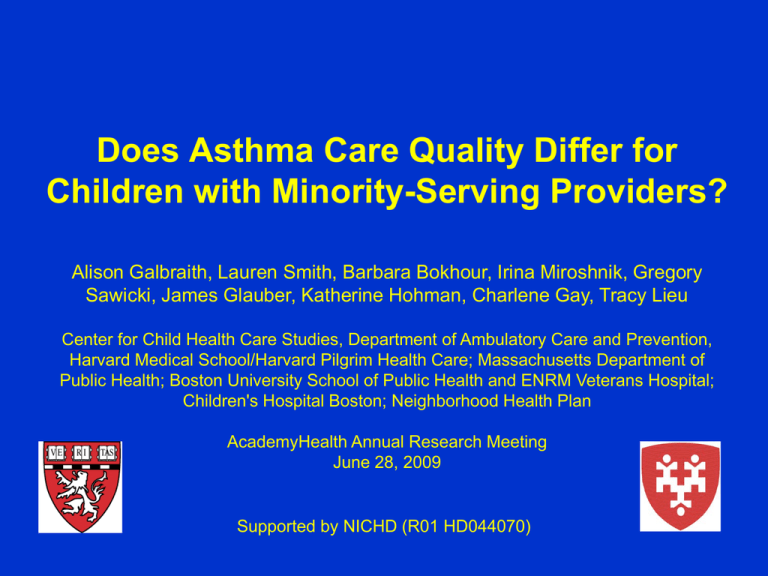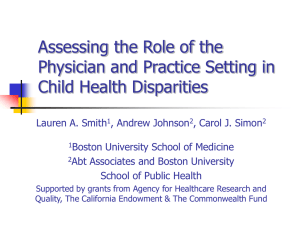Does Asthma Care Quality Differ for Children with Minority-Serving Providers?
advertisement

Does Asthma Care Quality Differ for Children with Minority-Serving Providers? Alison Galbraith, Lauren Smith, Barbara Bokhour, Irina Miroshnik, Gregory Sawicki, James Glauber, Katherine Hohman, Charlene Gay, Tracy Lieu Center for Child Health Care Studies, Department of Ambulatory Care and Prevention, Harvard Medical School/Harvard Pilgrim Health Care; Massachusetts Department of Public Health; Boston University School of Public Health and ENRM Veterans Hospital; Children's Hospital Boston; Neighborhood Health Plan AcademyHealth Annual Research Meeting June 28, 2009 Supported by NICHD (R01 HD044070) Background • Health care for minority patients is concentrated in a sub-set of providers • Minority-serving providers may not be able to provide same quality of care • Few studies on children, or on asthma care, where racial/ethnic disparities are well-documented Objective • To compare asthma care quality for children with and without minority-serving providers Methods • Design: Cross-sectional telephone survey of parents, linked with a mailed survey of children’s providers • Setting: A Medicaid-predominant health plan and a multispecialty provider group in Massachusetts • Population: Children aged 2-12 years with persistent asthma identified from claims and encounter data Methods • Primary Outcomes: parent report of whether the child had: – ever received inhaled steroids or had them recommended – received influenza vaccination in past season – received asthma action plan in past year • Primary Predictor Variable: whether the child’s provider was minority-serving (>25% of patients black or Latino) Analyses • Chi square and Fisher’s exact tests for bivariate analyses • Generalized linear mixed models – Began with unadjusted models including only child’s race/ethnicity – Added child, then provider-level variables • Except for minority-serving provider, co-variates included only if significantly associated with outcome in bivariate analyses Results • Response rate: – Parent survey: 72% – Provider survey: 73% • Linked parent and provider surveys available for 563 children and 138 providers Study Population % (n=563 children) Child’s race/ethnicity White Black Latino Multi/Other 44.9 22.4 19.2 13.5 Child’s age in years <5 5-9 10-13 24.0 51.2 24.9 Income <100% FPL 100-199% FPL > 200% FPL 21.4 18.1 60.5 Parent education < high school 25.3 Medicaid insurance 27.4 Provider Characteristics for Study Children % (n=563 children) Minority-serving provider 50.1 Provider race/ethnicity White Black Latino Asian 75.8 8.0 6.2 10.0 Provider years in practice <10 10-20 >20 4.2 20.4 75.5 Provider practice type Health center Hospital clinic Multi-specialty group Single-specialty/solo practice 13.2 3.6 72.6 10.6 Asthma Care Quality Outcomes % Not Receiving (n=563) Inhaled steroids Influenza vaccination Action Plan Child’s race/ethnicity White Black Latino Multi/Other 9.9 10.5 22.6 19.7 29.6 30.2 30.6 29.0 48.7 40.2 51.5 56.9 Minority-serving provider Yes No 16.9 10.7 29.4 30.3 46.1 50.8 p <0.05 in pink Characteristics associated with not receiving inhaled steroids OR (95% CI) Race/ethnicity White Black Latino Multi/other Unadjusted model Final model ref 1.10 (0.53-2.29) 2.64 (1.42-4.94) 2.28 (1.12-4.62) ref 1.07 (0.43-2.66) 1.76 (0.74-4.18) 1.62 (0.66-3.99) Parental education ≤ high school 2.30 (1.18- 4.84) Minority-serving provider 1.29 (0.63-2.64) Practice type Health center Hospital clinic Single-specialty/solo practice Multi-specialty group 4.88 (1.70-14.02) 4.53 (1.09-18.92) 1.23 (0.46-3.29) ref Adjusted model controls for variables listed, plus income, insurance type, and bronchodilator and systemic steroid fills. Characteristics associated with not receiving influenza vaccination OR (95% CI) Race/ethnicity White Black Latino Multi/other ref 1.16 (0.66-2.02) 1.30 (0.74-2.27) 1.03 (0.55-1.90) Child’s age in years <5 5-9 10-13 0.33 (0.19-0.58) 0.44 (0.28-0.69) ref Minority-serving provider 0.86 (0.56-1.32) Adjusted model controls for variables listed, plus single parent household and systemic steroid fills. Characteristics associated with not receiving asthma action plan OR (95% CI) Race/ethnicity White Black Latino Multi/other ref 0.70 (0.40-1.22) 0.97 (0.56-1.69) 1.21 (0.66-2.21) Child’s age in years <5 5-9 10-13 1.71 (0.99-2.96) 1.72 (1.08-2.76) ref Medicaid insurance (vs. private) 1.73 (1.09-2.74) Minority-serving provider 0.80 (0.49-1.30) Adjusted model controls for variables listed, plus bronchodilator fills. Limitations • Generalizability • Unmeasured patient and provider factors • Self-reported data Conclusions • Children with persistent asthma were less likely to receive inhaled steroids if they received care in community health centers or hospital clinics • Practice setting mediated initially-observed disparities in inhaled steroid use by Latino children and those with minority-serving providers Conclusions • No differences by race/ethnicity or minority-serving provider for influenza vaccinations and asthma action plans Implications • Findings do not support the hypothesis that minority-serving providers deliver lower-quality asthma care • Quality improvement efforts should consider focusing on community health centers and hospital clinics, which disproportionately serve minority children Implications • Policies promoting pay-for-performance and public reporting of quality measures should consider effects on providers in practices serving minority children


